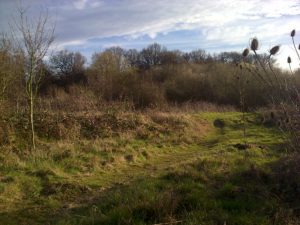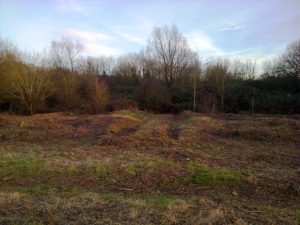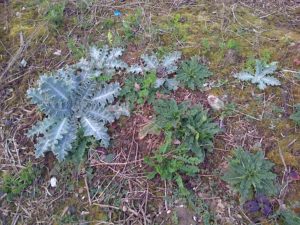There were more signs of spring at London Wildlife Trust’s Braeburn Park reserve, over the railway line from Hall Place, on 9th March. It being a workday, there wasn’t much time for walking around recording wildlife, but a Peacock, a male (and possible female) Brimstone and a Comma butterfly were seen thanks to the mild and sunny conditions.

A pathway at Braeburn park. Bramble and scrub grade into mature secondary woodland on the south scarp of the Cray valley. (Photo: Chris Rose)
There has been some thinning of scrub (mainly Bramble), particularly in areas where nationally and regionally scarce plants were becoming overwhelmed due to the lack of informed and targeted vegetation management prior to the Trust taking over at the site. Various areas of bank have also been opened up to provide hot sunny areas for various less common invertebrate species.

Bramble clearance at Braeburn Park. This may look drastic, but is essential to ensure that nationally and regionally scarce plants including Yellow Vetchling, Wild Basil and Hairy St. John’s-wort survive on the site. (Photo: Chris Rose)
It’s too early in the season to see the effects of this yet, but a patch of 6 Scotch Thistle and 30 Verbascum seedlings which had come up in a cleared area some time ago were still in evidence. A small specimen from a patch of a perennial Spurge, that had survived its previous sojourn in a Bramble thicket, was taken home to sort out the identification at a later date.

These Scotch Thistle (Onopordum acanthium) seedlings have come up in an area cleared of Brambles. (Photo: Chris Rose)
Bramble is in many respects a valuable plant for wildlife, providing cover, nectar and later fruit, so much will be left, and care is being taken to ensure that the overall importance of the scrub and tree habitat for smaller bird species is not compromised.
As if to emphasise this, in the late afternoon a party of around 10 Linnets flew into various smaller trees and a single Greenfinch was calling. There were 4, possibly more, Song Thrushes singing towards dusk, in what is one of the best places in the Borough to hear several of these birds at once. A few Ring-necked Parakeets went over, heading for the Danson Park night roost.
Braeburn Park is open to the public 24/7, and can be accessed from the west end of Lower Station Road, Crayford, from Galloway Drive and from a sloping pathway down from the side of the A2 just south of the Crayford-Bexley rail line. It has not been well-recorded to date, even by the Borough’s birders, so more observers would be welcome.
There is a large amount of work to be done here and a lot more help is needed with vegetation work and getting rid of years of littering and embedded rubbish before the cut-back Brambles start to re-grow. Watch the ‘Bexley Wildlife’ calendar for events you can get involved with here, or contact site manager “Shaun Marriott” <smarriott@wildlondon.org.uk>
Chris Rose
